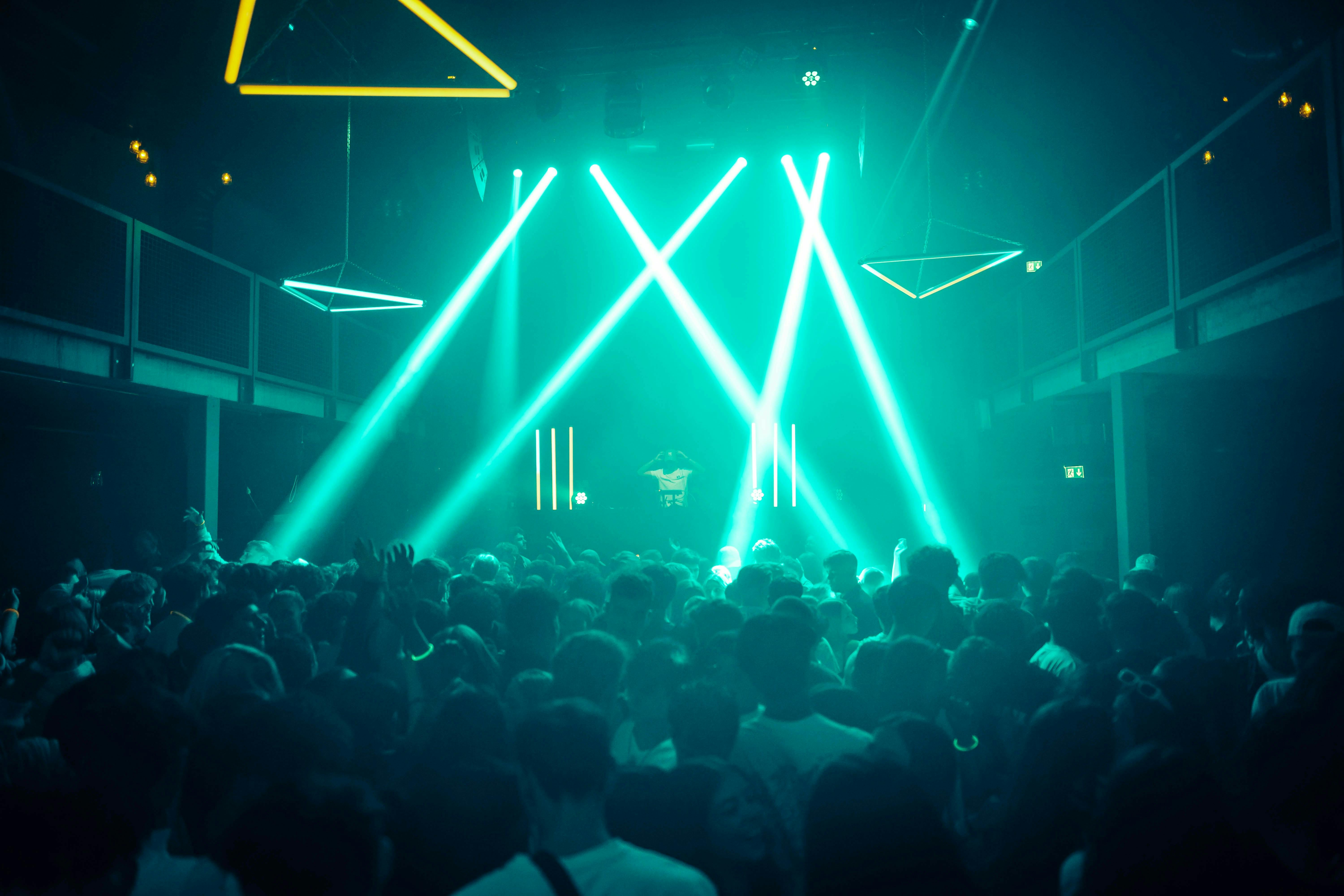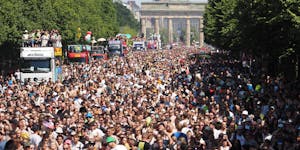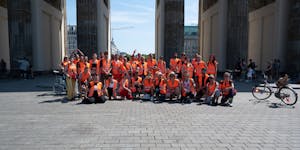The Journey to Intangible Cultural Heritage
Excerpts from the application & Basics about UNESCO
The inclusion of “Techno Culture in Berlin” in the Nationwide Directory of Intangible Cultural Heritage by the German UNESCO Commission has sparked significant public interest and initiated a broad debate. This is highly encouraging, yet it has repeatedly highlighted the complexity of the issue and where the difficulties in understanding lie.
With this article, we are publishing excerpts from our application for the first time, which are highlighted in quotes and color-coded. They represent the key points of the respective sections and aim to provide an idea of the overall scope of the application.
Our goal is to facilitate a better basic understanding and, at the same time, address the most frequently asked questions from the Rave The Planet community. The resulting transparency is intended to convey the significant value of “Techno Culture in Berlin” and promote societal recognition, positive discussion, and participation.
Basics: What you need to know
What is Intangible Cultural Heritage?
Intangible cultural heritage is everything that a community, a group, or even an individual considers as part of their tradition. This can include practices, customs, specific forms of expression, knowledge, or skills. It’s a vibrant part of our culture and closely connected to the people who practice and creatively evolve it.
This means that intangible cultural heritage can also change over time, influenced by societal developments, innovations, and transformations. The key to preserving this heritage lies in actively passing it on to the next generation.
What is UNESCO?
UNESCO stands for “United Nations Educational, Scientific and Cultural Organization.”
It is a specialized agency of the United Nations focused on promoting international cooperation in education, science, culture, and communication. Its goals include promoting peace, security, education, science, culture, as well as respecting human rights and fundamental freedoms.
Convention for the Safeguarding of the Intangible Cultural Heritage
In 2003, the UNESCO General Conference adopted the Convention for the Safeguarding of the Intangible Cultural Heritage, which came into force in spring 2006 after ratification by 30 states.
Today, 181 countries are parties to this agreement. These include nations from all regions of the world, such as France, China, India, Mexico, Egypt, and many others. Germany joined the Convention in 2013.
However, there are also some countries that have not signed the agreement. These include Israel, Syria, South Sudan, Brunei, Palau, and the United States of America.
Application procedure for the Nationwide Inventory in Germany
The recognition of a cultural form as part of the Intangible Cultural Heritage involves a multi-stage application process. Proposals for inclusion in the inventory come from civil society, meaning from the people who live and practice these cultural traditions.
Every two years, there is an application round where a nationally standardized application form must be used. All applications must comply with the requirements of the UNESCO convetin and meet specific criteria (see below). They are submitted to the respective federal state within Germany, which then makes a preselection and can forward up to four applications to the Secretariat of the Standing Conference of the Ministers of Education and Cultural Affairs.
The nationwide list of proposals is then transmitted to the independent Expert Committee on Intangible Cultural Heritage at the German UNESCO Commission. This committee examines and evaluates the applications according to the established criteria and recommends cultural forms for inclusion in the inventory.
Finally, the Conference of Ministers of Culture of the Federal States and the Federal Government Commissioner for Culture and the Media confirm the selection recommendations of the committee. The selected cultural form is then included in the national inventory, which in Germany is titled “Nationwide Inventory of Intangible Cultural Heritage.”
UNESCO has also created global lists for the preservation of Intangible Cultural Heritage. Only cultural forms that are already listed nationally can be proposed by UNESCO member states for these lists.
Aufnahmekriterien
The criteria for inclusion in the National Inventory are defined in the 2003 UNESCO Convention for the Safeguarding of the Intangible Cultural Heritage. For instance, the respective cultural form must be demonstrably alive, meaning it is actively practiced and maintained by communities.
Another important requirement is that the creative transmission and development occur through the so-called bearer communities, meaning the people who practice this cultural form are actively involved in preserving and evolving it.
Furthermore, the German UNESCO Commission places great emphasis on additional points, such as a nuanced historical reflection and the presentation of connections to similar cultural expressions in Germany, Europe, and beyond.
Find all requirements and inclusion criteria on the UNESCO website (German only).
Application: Techno Culture in Berlin
Geographical Localization
The UNESCO initially collects basic information in its application forms and is interested, for example, in where exactly the respective cultural practice takes place, is exercised, and nurtured.
“The beginnings of German techno are disputed. While Frankfurt posed strong competition for many years, techno experienced its greatest breakthroughs under the dramatic conditions following the fall of the Berlin Wall, with effects spreading across the entire country and new scenes emerging overnight.
Since the fall of the Berlin Wall, techno has represented the sonic ethos of the city of Berlin, equally reflecting its past and present…”
Brief Description of the Culture Form
“The techno culture in Berlin is a subculture centered around the music style techno,… Besides the music, it encompasses a myriad of expressive forms – from avant-garde performances to visually stunning art installations – all steeped in a subcultural ethos that resonates deeply within the city’s cultural fabric (Bonz 2016). While techno has evolved into a global phenomenon since the early ’90s, its heart beats strongest in Germany.”
A defining moment in history was the year 1989 when droves of revelers descended upon Berlin to share in the euphoria of the Fall of the Berlin Wall, with techno music serving as the anthemic backdrop to this monumental event.
“Even three decades on, the party spirit remains a communal experience for Berliners and tourists alike, solidifying Berlin’s status as the epicenter of international club and techno culture (Schofield, Rellensmann 2015). Iconic clubs like Berghain, Tresor, and Watergate, along with techno hubs such as the RAW-Gelände and Elsenbrücke venues, as well as techno parades – a quintessentially Berlin form of political expression (inaugurated by the first Love Parade in 1989) – showcase the boundless diversity of Berlin’s offerings.”
Yet, over the past two to three decades, Berlin has undergone a seismic shift. Rampant gentrification has encroached upon the city’s subcultural and independent scenes, with clubs and alternative venues feeling the squeeze of economic pressures. Some have been forced to shutter their doors or relocate to the outskirts, endangering the very essence of Berlin’s Techno Culture, often nestled within the historic confines of the city center.
“At the core of preserving Berlin’s Techno Culture lie its venues. They serve as the custodians of not just the music, but also the distinct ethos that defines it, ensuring its legacy is passed down from one generation to the next.”
Today’s Practice
The dance events (raves) and the music itself constitute the core of the cultural form. They create a distinct social environment marked by openness, peace, friendliness, and freedom.
“The sense of belonging, which is both ephemeral for a single night yet enduring across lifetimes, often described as ‘family,’ remains one of Techno’s defining elements. In an era where traditional identity-establishing institutions like the church are fading, the Techno scene offers a contemporary and liberal lifestyle through non-traditional communities (Hitzler, Pfadenhauer 2001).”
Origin and Evolution
Techno music draws on various musical developments, including the advent of electric sound generation in the 20th century, the emergence of Detroit Techno, Chicago House, Belgian EBM, Italo Disco, New Wave, and Acid House in the UK, culminating in the second ‘Summer of Love’ in 1988.
“In Germany, the Frankfurt and Berlin club scenes established themselves in the mid-80s, but it was after the fall of the Berlin Wall that Berlin’s culture truly blossomed. Stemming from the DJ culture of previous years, Techno became the soundtrack of the extraordinary times and the spirit of renewal after reunification (cf. Denk and Thülen 2014). The open spaces provided fertile ground for the Techno and club scene to flourish, making Berlin the epicenter of this culture unlike anywhere else (cf. Fuchs 2007). As its popularity grew, so did the interest from record labels and investors, often leading to commercialization trends that parts of the scene, as well as younger generations, have pushed back against through counter movements…
Since its inception, Techno has seen roughly four generations blending together and continually reinventing the culture. This is exemplified by the DJs, who act as music curators, influenced by a rich artistic and social exchange, and who, with their extensive music collections, blend sounds from the past and present (cf. Attias, Gavanas, Rietveld 2013).”
Reflection of History
In the application form, not only the cultural form itself is considered, but also its historical and societal significance. UNESCO desires a critical examination of its history, especially that of the 20th century and events such as National Socialism, the Soviet occupation period, and the SED rule in the GDR. Topics such as colonialism, wars, migration, current societal debates, or controversies, if applicable, should also be addressed.
“After the fall of the Berlin Wall, due to a lack of clear authority, there were vast amounts of real estate in uncertain ownership and usage situations. Many open spaces were accessible for about a decade, leading to their occupation and the blossoming of artistic expression within the techno scene. The echoes of National Socialism and Berlin’s division were still present. Partying became a way to move past the past by creating spaces for peaceful, joyful interaction on equal footing. The significant contribution of Detroit artists and the African-American heritage are to be emphasized as origins…
Present-day debates revolve around issues of inclusion and exclusion, the promotion of a carefree/hedonistic lifestyle, depoliticization (Monroe 2017), gender equality, digitization, and, most importantly, commercialization, its definition, and its boundaries, as the original motivation was not profit-driven. Many see collaboration with industry and commerce as eroding the ‘Techno Spirit’…”
Impact and Sustainability
The application form also asks about the impacts and importance of techno culture beyond its own communities and groups. This includes considering influences on pop culture as well as aspects of social, economic, and ecological sustainability.
“The techno culture is based on a highly developed world of music, art, and technology. The digital art scene evolved parallelly and collaboratively with it… The impulses permeated society, as evidenced by fashion. Elements of it are trending among younger generations today.
Economically speaking, the techno scene is sustainable as it creates numerous job opportunities, especially opening up social avenues for marginalized individuals. Furthermore, studies have clearly shown that Berlin benefits from what’s known as techno tourism…
The most significant contribution of Techno Culture is to social sustainability. Thanks mainly to the queer scene, events are often places of free self-expression, which many perceive as ‘safe spaces.’ Barriers related to clothing, origin, age, mindset, language, gender, sexual orientation, and income tend to fade away.”
European Reference
In this section of the application form, UNESCO is asking about the connections between this cultural form and others in Europe, what interactions there have been, and how cross-border collaboration is happening today.
“Besides the trailblazing musicians, alternative youth scenes in Europe and around the world paved the way for techno. There are overlaps with the rebellious style of punks, the consumer-focused attitude of the poppers, and the peacefulness of the hippies…”
Furthermore, it was also highlighted that communal dancing and self-expression are at the heart of techno culture. The influences of the New York gay scene were emhasized, where clubs became a “forum for the liberated body” (Coers 2000).
These and other influences from North America played an important role in the development of Techno Culture in Berlin, which is why the application also referred to non-European connections.
“Despite its roots in Detroit, techno only truly flourished through its evolution in Europe: ‘Alongside the energetic rave tracks from Great Britain, the Netherlands, and Belgium, the afro-futuristic visions became a spiritual catalyst for that movement which was to redefine the current landscape of Berlin, helping to shed its 1980s image as a gloomy Cold War enclave and establishing it as one of Europe’s most vibrant and creative cities.’ (Collin 2018)
While techno quickly spread globally, it never quite took hold in the United States like other genres did. That’s why today, techno finds its stronghold in Germany, particularly in Berlin, thanks to the exceptional and unique historical circumstances surrounding German reunification.
From the outset, techno culture has been globally interconnected in the context of globalization and digitization. The neutral matrix of electronic sounds, which can be understood independently of language and culture, has led many national music scenes to contribute their interpretations to the basic style. Through the movement of actors and works, intensive exchange and mixing continue to take place today. Berlin, thanks to its special historical relevance, leads the way in this regard and is globally regarded as the capital of techno.”
Risk Factors for the Preservation
After the cultural form has been extensively described, UNESCO wants to understand the need for protection and potential risk factors for its preservation. This includes considering both the possible positive and negative effects of listing it in the Intangible Cultural Heritage Inventory, so as to fully comprehend its impact on the communities and groups actively engaging in the cultural practice.
“A major risk to the continuity of Techno Culture is the ‘club dying’ (German: Clubsterben) phenomenon, as it requires spaces where the culture can thrive. Over the decades, many historical clubs have already had to close or relocate. For instance, investors bought occupied buildings, leading to their closure (Coers 2000). More profitable uses are prioritized…
Another reason lies at the legal level. The requirements for opening or operating a club are increasingly stringent. Neighborhood protection, fire, and noise regulations entail too much capital and risk for opening a club to be affordable. Especially young people thus face significantly more difficult conditions to establish themselves in Techno Culture… By making Berlin attractive as a city, techno has also become appealing to entrepreneurs focused on increasing value…
Often, the focus can no longer be on cultural work, but only on survival. The COVID-19 pandemic has made it clear that techno culture and its proponents receive little protection. One of the reasons is the derogatory societal attitude. Discrediting labels such as ‘drug scene,’ ‘hedonists in moral decline’ are exemplary (Klein 2004).
Furthermore, another threat arises, especially from the development driven by commercial social media platforms like Instagram and TikTok, which increasingly portray techno as a consumable fashion product, leading to widespread uniformity and exclusion mechanisms (Groove Magazine 2022).
To sustain Techno Culture in Berlin, there needs to be more awareness of its broader societal importance. This requires supportive policies, laws, and long-term planning security.”
Closing Remarks
The quoted passages above are just a snippet of the whole application. Additionally, measures for preservation, access to culture, knowledge transmission, and much more were also explained.
Putting together the application involved diving into academic texts and conducting numerous interviews with key figures and experts in the scene. We included 10 standout photos, around 50 letters of endorsement from the cultural sector and from culture-related organizations, along with two professional cover letters and a hefty list of supporters who signed our backing petition.
Plus, the short documentary “Techno Culture in Berlin” on our YouTube channel was submitted with the application.
Big shoutout to all the supporters whose commitment and contributions have made this application possible.
Bibliography & Sources (Excerpt)
Alexei Monroe „Sender Deutschland – The Development and Reception of Techno in Germany“ (from the book „German Pop Music“ von Uwe Schütte, De Gruyter)
https://www.degruyter.com/document/doi/10.1515/9783110425727-009/htmlBernardo Attias, Anna Gavanas, Hillegonda Rietveld „DJ Culture in the Mix Power, Technology, and Social Change in Electronic Dance Music“ (Bloomsbury Academic)
https://www.bloomsbury.com/uk/dj-culture-in-the-mix-9781623560065/Christina Plett „Techno auf TikTok: Schnelle Brillen und sehr viel Cringe“ (Groove Magazin 2022)
https://groove.de/2022/12/08/techno-auf-tik-tok-schnelle-brillen-und-viel-cringe/Felix Denk, Sven von Thülen „Der Klang der Familie – Berlin, Techno und die Wende“ (Suhrkamp Verlag)
https://www.suhrkamp.de/buch/der-klang-der-familie-t-9783518465486Gabriele Klein „Electronic Vibration – Pop Kultur Theorie“ (VS Verlag für Sozialwissenschaften)
https://link.springer.com/book/10.1007/978-3-322-80987-2Jochen Bonz „Sound Signatures – Pop-Splitter“ (Edition Suhrkamp)
https://www.suhrkamp.de/buch/sound-signatures-t-9783518121979John Schofield, Luise Rellensmann „Underground Heritage: Berlin Techno and the Changing City“ (Heritage & Society)
https://www.tandfonline.com/doi/full/10.1080/2159032X.2015.1126132Kim Feser, Matthias Pasdzierny „Techno Studies – Ästhetik und Geschichte elektronischer Tanzmusik“ (B-books)
https://www.bbooks.de/verlag/techno-studiesMartin M. Coers „Friede, Freude, Eierkuchen: Die Technoszene“ (C. H. Beck)
https://www.zvab.com/9783406459146/Friede-Freude-Eierkuchen-Technoszene-Coers-3406459145/plpMatthew Collin „Rave On – Eine globale Reise durch die Electronic Dance Music“ (Hannibal Verlag)
http://www.hannibal-verlag.de/cgi-bin/WebObjects/TXTSVHannibal2.woa/641/wo/tq3i9NIGzhYE29lQhxl98TXybvW/4.0.SuperPage.11.1.5.1.3.13.1.0.11.0Meike Jansen „Gendertronics – Der Körper in der elektronischen Musik“ (Suhrkamp Verlag)
https://www.suhrkamp.de/buch/gendertronics-t-9783518123942Michael Fuchs „Die sprachlose Jugendkultur Techno: Ein Gegenentwurf zum Rationalismus“ (AV Akademikerverlag)
https://my.akademikerverlag.de/catalog/details/store/gb/book/978-3-639-40554-5/die-sprachlose-jugendkultur-technoNadja Wirth „Ecstasy, Mushrooms, Speed und Co. – Das Info-Buch“ (Econ Verlag)
https://www.zvab.com/9783612264107/Ecstasy-Mushrooms-Speed-Info–Buch-3612264109/plpRonald Hitzler, Michaela Pfadenhauer „Techno-Soziologie – Erkundungen einer Jugendkultur“ (VS Verlag für Sozialwissenschaften)
https://link.springer.com/book/10.1007/978-3-663-11611-0Tobias Rapp „Lost and Sound Berlin, Techno und der Easyjetset“ (Suhrkamp)
https://www.suhrkamp.de/buch/tobias-rapp-lost-and-sound-t-9783518460443
Header photo by Kajetan Sumila on Unsplash





















